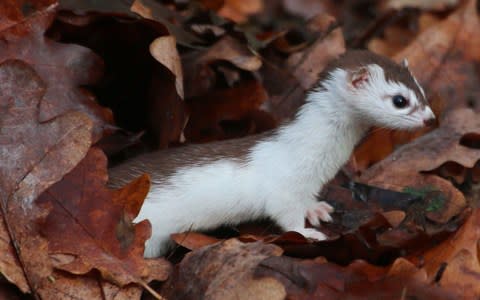White-furred animals could die out because of climate change, study suggests

White-furred animals are in danger of dying out because climate change is causing a fall in snow cover, leaving them exposed and vulnerable, a new study suggests.
Scientists in Poland have been following the worrying case of the white-coated weasel, which sheds its tawny covering in the winter for a milky coat allowing it to blend effortlessly into its icy environment.
But researchers have discovered that between 1997 and 2007 the number of days with permanent snow cover in Białowieża Forest, Poland, halved, from 80 to 40.
It means that the little creatures are being caught out in a completely unsuitable environment, where they are easy prey for predators like foxes and crows.
The team at the Polish Academy of Sciences found that on days when there was little winter snow cover, the number of white-coated weasels they managed to capture fell to as low as 20 per cent of the total, suggesting the rest had been killed.
We should not underestimate the power of natural selection
Dr Karol Zub
Previously they would have been dominant, because their coats would have given them a survival advantage.
The problem is likely to affect other white-furred mammals and birds living in areas vulnerable to climate change such as the Arctic fox as the snow cover increasingly gives way to a landscape of greens and browns.
Scientists have recorded 21 mammal and bird species which turn white in the winter to hide themselves in snowy landscapes including the mountain hare, the Siberian hamster, the collared lemming, the white-tailed jackrabbit and the willow ptarmigan bird.
Author Dr Karol Zub, told The Telegraph: “Definitely the same rules apply to all seasonally moulting mammals and birds.
“According to studies on showshoe hares during periods when hares are colour mismatched weekly survival probability decreases by 3.3 - 6.5 per cent. This seems not to be a big effect, but the cumulative effect over winter can seriously influence mortality of the species.
“It is very probable that in the near future white weasels and stoats will disappear completely from many areas of Northern Europe and North America.
"They will ether be replaced by brown morphs or they will evolve and moult later in the season, being only partly white for a relatively short period.”

The weasel species Mustela nivalis has two subspecies with differently coloured winter coats, white and brown, which coexist in the same habitat.
Researchers also carried out tests using toys of brown and white-coated weasels to see if the colours were actually making a difference to predators.
When they set up camera traps they found dozens of animals, such as foxes, wolves and birds of prey had approached the white toys, but none had shown interest in the brown versions.
The authors say both findings suggest that the decrease in white-coated weasels is due to an increase in detection by predators in a less snowy environment.
The researchers are hopeful the animals will learn to adapt, but say they cannot rule out the animals vanishing entirely.

Weasels that do not change colour in the winter, are more likely to survive to pass on their brown-coated genes, increasing the numbers of the darker species.
Dr Zub added: “We should not underestimate the power of natural selection. We hope that along with future climate warming, autumn temperatures will also increase, providing an additional signal to the weasels to delay their moult.
“Last autumn in our study was extremely mild and under such conditions about half the weasels we observed started to moult at the begin ing of January whereas most weasels complete their moult by the end of November.”
The research was published in the journal Scientific reports.

 Yahoo News
Yahoo News 
